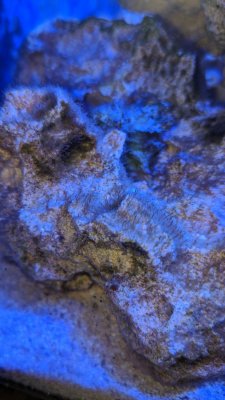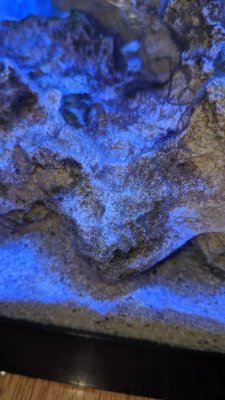20 gallon long
Tank Parameters
Ammonia: 0ppm
Nitrates:0ppm
Nitrites :0ppm
pH:8
Alk: 11
Calcium:320(I'm new to reefing would appreciate advice onhow to get this up to 400 range too)
Phosphate;0.1( added gfo and chemo pure, going down to 0.05)
Tank inhabitants:
Yellow tail damsel
8 hermit crabs (Scarlett and blue legs)
2 nassarius snails ( I had around 8-10 snails of different varieties and most of them died off which I read is a key sign of Dinos)
Hey everyone! First post on here and I'm looking for some help on Id-ing and combating Dinoflagellates. I'm unsure because although it looks like Dinos, they don't have the air bubble which is on all the pictures I'm seeing of other people's dino problems. It's mostly growing on rocks, not much on sandbed.
My tank is around 3 months old including 5 week cycling, and I currently don't have any corals because I've been busy combating annoying pests like byrposis(completely gone, got from original live rock) and red slime(almost completely gone).
Im thinking of doing a 3 day blackout, wont really hurt anything since I'm coralless, and doing a dose of 2ml of food safe hydrogen peroxide for a few days.
I would appreciate any and all help you can give, including how to take better pictures of what's in my tank, especially small stuff like this.


Tank Parameters
Ammonia: 0ppm
Nitrates:0ppm
Nitrites :0ppm
pH:8
Alk: 11
Calcium:320(I'm new to reefing would appreciate advice onhow to get this up to 400 range too)
Phosphate;0.1( added gfo and chemo pure, going down to 0.05)
Tank inhabitants:
Yellow tail damsel
8 hermit crabs (Scarlett and blue legs)
2 nassarius snails ( I had around 8-10 snails of different varieties and most of them died off which I read is a key sign of Dinos)
Hey everyone! First post on here and I'm looking for some help on Id-ing and combating Dinoflagellates. I'm unsure because although it looks like Dinos, they don't have the air bubble which is on all the pictures I'm seeing of other people's dino problems. It's mostly growing on rocks, not much on sandbed.
My tank is around 3 months old including 5 week cycling, and I currently don't have any corals because I've been busy combating annoying pests like byrposis(completely gone, got from original live rock) and red slime(almost completely gone).
Im thinking of doing a 3 day blackout, wont really hurt anything since I'm coralless, and doing a dose of 2ml of food safe hydrogen peroxide for a few days.
I would appreciate any and all help you can give, including how to take better pictures of what's in my tank, especially small stuff like this.















